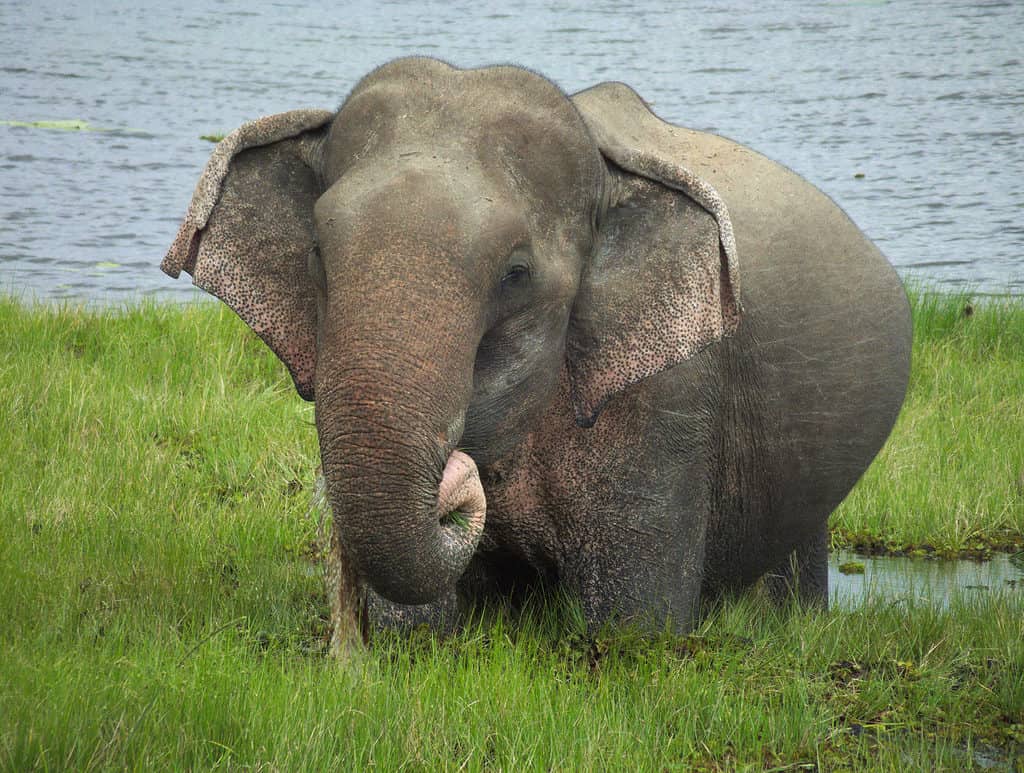Elephants are some of the most popular animals worldwide. That is no surprise as they are the largest living terrestrial animals, towering up to 12 feet and reaching up to 14,000 pounds in mass. With an enormous size, it is almost impossible to mistake another animal for an elephant. Elephants bear trunks, tusks, large ears, and leathery skin, which is often gray. However, not all elephants are gray. Various factors determine the skin pigments of these giants, and this article reveals the different colors of elephants and why there are variants.
Elephant Skin: What Does It Look Like?

Elephants have wrinkled skin.
©iStock.com/Lekamalage
According to Seaworld Parks & Entertainment, elephant skin is leathery and wrinkled. The wrinkles are not a sign of old age like in humans, but a cooling mechanism to increase their skin surface area, allowing for greater heat loss.
According to the Elephant Sanctuary, elephants lack sweat glands. Thus, they bathe in water and mud pools, flap their ears, and retain moisture in their wrinkles to cool themselves. Given the harsher heat in Africa, African elephants have more wrinkles than Asian elephants. The Asian counterparts do not need as many wrinkles as they live in forested habitats with lower temperatures.
Despite the thickness of the elephant’s skin, it is sensitive to touch and enables elephants to tolerate cold conditions. The most prominent skin color of elephants is gray, but there have been rare occurrences of other colors.
What Are the Different Colors of Elephants?

Elephants are generally gray.
©Pooja Prasanth/Shutterstock.com
Elephant species are not so differentiable by color. They are often gray. However, elephants can sometimes have other colors or even speckles on their skin. Below are the different colors of elephants:
Shades of Gray
Gray is the most prominent color of elephants, and it can sometimes vary from a light gray to grayish black. According to reports, Asian elephants have darker coloration than their African counterparts, taking a dark gray color.
Though African elephants have more wrinkled skin than Asian elephants, their skin coloration is often more consistent. Asian elephants sometimes develop patches on their skin as they grow older.
Pink
According to news reports, albino elephants, commonly called white elephants, have been revered in Thailand and other Asian nations for centuries. These elephants are referred to as “white elephants” despite their pink color to portray purity instead of color. Due to their rarity, these pink giants are often regarded as royalty and sacred, and are given as precious gifts and used in the army.
Pink elephants are characterized by fair eyelashes and toenails. These unique elephants can often be ousted by their herds, who abandon them because they look different. These albino giants are susceptible to blindness and skin problems upon exposure to harsh sunlight because of the lack of skin pigments.
Why Do Elephants Have Different Colors?
1. Albinism
Albinism is a genetic mutation that causes a complete lack of pigments in animal eyes and skin. It results from a lack of melanin, responsible for skin, eyes, hair, and feather colors. According to Wildlife Conservation Trust, albinism in elephants is about one in 10,000 births, with about 70 existing worldwide. These unique elephants have pink skin and pale eyes, and this odd color can cause isolation among herds.
This mutation reduces the chances of survival of these elephants. Albinism can result in health conditions due to harsh sun and also blindness. Albino elephants, or pink elephants, cope by hiding under their mother’s shadows and mud baths which act as sun-screen.
2. Leucism
According to Kruger National Park, leucism is a condition that causes animals to get darker with age. However, the backs of their ears remain pink throughout their lives. Leucism and albinism are similar as they both involve a lack of skin pigments, but leucism is a partial loss.
According to Global Sanctuary for Elephants, pink pigmentation is common among Asian elephants with patches on their bodies and trunks. However, this is not leucism, and this pink skin can be caused by genetics, age, habitat, and nutrition.
3. Mud Baths
In an attempt to cool themselves, elephants sometimes bathe in mud. The mud bath can give the large animal a red skin color which can remain on them for days until they wash it off. Thus, brown and red elephants do not exist. These colors are of the soils in their environment.
Elephants bathe in mud and sometimes throw dust onto their bodies to regulate their temperatures. Once they are bathed in clear water, their grayish color is revealed underneath again.
Up Next:
What Is a Group of Elephants Called?
What Do Elephants Eat? Their Diet Explained
What Is the World’s Largest Elephant?
Mammoth vs. Elephant: What’s the Difference?
The photo featured at the top of this post is © JohnEGoodwin/Shutterstock.com
Sources
- , Available here: https://seaworld.org/animals/all-about/elephants/characteristics/
- , Available here: https://www.usatoday.com/story/news/world/2015/03/01/burma-rare-white-elephant/24215533/
- Linda Chivell, Available here: https://www.elephantsanctuary.co.za/blog/137-how-does-the-skin-of-african-elephants-get-so-wrinkled
- , Available here: https://wildlifeconservationtrust.co.za/albinism-in-elephants/
Thank you for reading! Have some feedback for us? Contact the AZ Animals editorial team.






